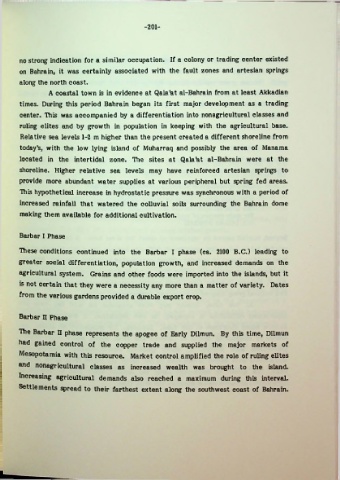Page 225 - Life & Land Use on the Bahrain Islands (Curtis E Larsen)
P. 225
-201-
no strong indication for a similar occupation. If a colony or trading center existed
on Bahrain, it was certainly associated with the fault zones and artesian springs
along the north coast.
A coastal town is in evidence at Qala’at al-Bahrain from at least Akkadian
times. During this period Bahrain began its first major development as a trading
center. This was accompanied by a differentiation into nonagricultural classes and
ruling elites and by growth in population in keeping with the agricultural base.
Relative sea levels 1-2 m higher than the present created a different shoreline from
today’s, with the low lying island of Muharraq and possibly the area of Manama
located in the intertidal zone. The sites at Qala’at al-Bahrain were at the
shoreline. Higher relative sea levels may have reinforced artesian springs to
provide more abundant water supplies at various peripheral but spring fed areas.
This hypothetical increase in hydrostatic pressure was synchronous with a period of
increased rainfall that watered the colluvial soils surrounding the Bahrain dome
making them available for additional cultivation.
Barbar I Phase
These conditions continued into the Barbar I phase (ca. 2100 B.C.) leading to
greater social differentiation, population growth, and increased demands on the
agricultural system. Grains and other foods were imported into the islands, but it
is not certain that they were a necessity any more than a matter of variety. Dates
from the various gardens provided a durable export crop.
Barbar n Phase
The Barbar n phase represents the apogee of Early Dilmun. By this time, Dilmun
had gained control of the copper trade and supplied the major markets of
Mesopotamia with this resource. Market control amplified the role of ruling elites
and nonagricultural classes as increased wealth was brought to the island.
Increasing agricultural demands also reached a maximum during this interval.
Settlements spread to their farthest extent along the southwest coast of Bahrain.

